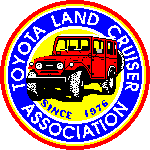
The Capital Land Cruiser Club
P.O. Box 3102, McLean, VA, U.S.A. 22103-3102


|
The Capital Land Cruiser Club
|

|
Must have features:
Volume control
RF Gain Control
4 Watts RF output
Squelch control
Microphone cord that is long enough
Nice to have features:
Illuminated Meter
Dim/Bright Switch
CB/PA Switch
Weather Channels (162.40 to 162.55 MHz) (WARNING: some CB's with Weather Band do not include all weather frequencies: a minimum of 7 weather frequencies should be available) See the bottom of the page for details.
SWR Calibration Control and SWR meter
Low Transmit-Power Switch
External Speaker Jack
Typically useless features:
Delta Tune Control
Single Side Band (SSB)
Variable Microphone gain
Accessories:
External Speaker
5/8 Wave Antenna
Microphone Holder
Things to consider:
Will the controls on the radio be easy to use when you encounter pot holes or dirt roads?
Red light impacts night vision less than other colors. Red light is preferable.
CB’s are basically cheap enough that it is cheaper to replace one than to have it repaired.
A cheaper CB at 4 watts with good antenna properly tuned will transmit farther than an expensive CB with a mis-tuned/poor antenna.
Buy a good 5/8ths wave antenna to maximize transmit range.
The choice of the antenna and it's mounting are as important as the quality of the radio.
An external speaker will almost always sound better than the speaker inside the radio. The speakers that come in many radios are built with one thing in mind: low cost. These tiny little speakers generate higher frequency sounds very efficiectly but they are not well suited to producing sound in the vocal range of 80-200Hz.
A transmit-power swith is a great feature that is found on many handheld CB's and is missing on most mobile CB's. The reason that this is a desirable feature is that receivers within a few truck lengths of your antenna can be overwhelmed by a full 4 watts. while they might be able to cope with a 1 watt transmitter. Inversely an RF Gain control allows your receiver to be less overwhelmed by transmissions from nearby transmitters.
Bumper height mounting a CB antenna is typically a very bad idea. Mounting to the top of a Bull Bar or brush/grill guard is usually OK. The simple-rule is minimize the amount of vertical sheet metal which is immediately next to the antenna ("RF radiator").
The channel indicator needs to be readable in both bright and dark conditions.
LCD displays tend to be hard to read when light is reflected off the shiny clear window which protects them.
High quality coaxial (antenna) cable can reduce the amount of ignition noise from the radios speaker.
Higher is usually drier: consider this when choosing where to mount radios and speakers.
The electrical "noise" which electrical devices like: receivers, transmitters, CD transports, Tape transports, and speakers generate can in rare instances interfere with each others operations. Typically 2 inches of distance from each other is FAR-MORE than enough to overcome this interference. Simply put: test before you mount.
Antenna length is a potential safety issue: long antennas (aka "whip" antennas) can reach out and injure someone. Some 4WD clubs do formally limit antenna length for both safety reasons and legal liability reasons. A 36 to 48 inch antenna should work fine and not exceed any clubs rules.
A good set of sheilded spark plug wires can reduce electrical noise significantly.
Exposure to sunlight (UV specifically) can damage coax cable over time (a very long time).
Any wire going through sheet metal should be grometed/bushed to avoid chafing.
Avoid running antenna coax near any ignition system components and exhaust system components. This reduces electrical noise and reduces heat-damage.
There are 7 VHF frequencies used by NOAA
|
|
| 162.400 | 162.425 |
| 162.450 | 162.475 |
| 162.500 | 162.525 |
| 162.550 | |
| This This document was written by Eugene Cole for Reference purposes only. |
| Over the years I have on numerous occasions found my self embroiled in discussion about selecting radio equipment.
A few years ago at a CLCC tech night a group of us were adjusting the valves of the F motor in "Grandpa" and we were discussing CB equipment selection. When I started explaining the reasoning behind my opinions someone in the group said I should write this up and put it on the Club Web Site. This was pretty funny at the time since we did not have a CLCC web site back then. Since that night I have started and restarted the process of compiling a document with these opinions and the reasoning behind them. This is for better and for worse the latest revision. |
 CLCC Home Page.
CLCC Home Page.
